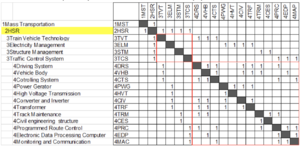High-Speed Rail Safety
Roadmap Overview
High-Speed Rail is a type of passenger rail transportation system that operates at high-speed with high voltage electricity. With respect for the multiple definitions for high-speed rail, the International Union of Railways defines high-speed rail as systems of rolling stock and infrastructure which regularly operate at or above 250 km/h on new tracks, or 200 km/h on existing tracks. Figure 8, above, shows the basic components of high-speed rail system. Rolling stock that obtain electricity from cable (as shown, or ground-based rail) as a power is operated by a driver who follows signals and communicates with one or more control centers. The dedicated or specifically upgraded tracks guide the train.
DSM Allocation
The DSM shows that the 2HSR is part of the mass transportation system in large context. It requires 3TVT Train Vehicle Technology, 3ELM Electricity Management, 3STM Structure Management, and 3TCS Traffic Control System. In addition, these level 3 technologies require level 4 technologies that are consist of 4 DRS Driving System of the vehicle such as motor, 4VHB Body of vehicles, 4CTS control system of the vehicle, 4PWG power generator or power plant of electricity, 4HVT technology for transmitting high voltage electricity, 4CIV converter and inverter inside the vehicle, 4TRF transforming electricity to appropriate voltage, 4TRM maintenance of tracks, 4CES maintenance of civil engineering structures such as bridges and tunnels, 4PRC route control system, 4EDP data processing unit, 4MAC technology for monitoring and communicating data.
Roadmap Model using OPM
Figures of Merit
| Figure of Merit | Units | Description |
|---|---|---|
| Maximum speed | km/hour | Maximum operational speed of trains |
| Frequency | # of trains/hour | Number of operated trains per hour |
| Weight | kg | Weight of train |
| Brake force | N | Force to stop the train |
| Brake stopping distance | m | Distance that it takes to come to a complete stop |
| Capacity | people/train | Number of passengers carried by train |
| Strength of Body | N/mm^2 | Strength against crash |
| CO2 emission | t/train/km | Amount of CO2 emitted by electricity generation used for operating one train |
| Construction cost | $/km | Initial cost for constructing total railway system per 1 km |
| Operation cost | $/train | Operational cost for a round-trip of a train |

